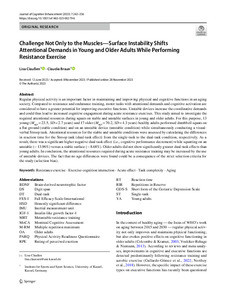| dc.date.accessioned | 2024-02-28T15:45:53Z | |
| dc.date.available | 2024-02-28T15:45:53Z | |
| dc.date.issued | 2023-11-28 | |
| dc.identifier | doi:10.17170/kobra-202402289696 | |
| dc.identifier.uri | http://hdl.handle.net/123456789/15517 | |
| dc.description.sponsorship | Gefördert im Rahmen des Projekts DEAL | |
| dc.language.iso | eng | |
| dc.rights | Namensnennung 4.0 International | * |
| dc.rights.uri | http://creativecommons.org/licenses/by/4.0/ | * |
| dc.subject | Resistance exercise | eng |
| dc.subject | Exercise-cognition interaction | eng |
| dc.subject | Acute effect | eng |
| dc.subject | Task complexity | eng |
| dc.subject | Aging | eng |
| dc.subject.ddc | 796 | |
| dc.title | Challenge Not Only to the Muscles - Surface Instability Shifts Attentional Demands in Young and Older Adults While Performing Resistance Exercise | eng |
| dc.type | Aufsatz | |
| dcterms.abstract | Regular physical activity is an important factor in maintaining and improving physical and cognitive functions in an aging society. Compared to resistance and endurance training, motor tasks with attentional demands and cognitive activation are considered to have a greater potential for improving executive functions. Unstable devices increase the coordinative demands and could thus lead to increased cognitive engagement during acute resistance exercises. This study aimed to investigate the required attentional resources during squats on stable and unstable surfaces in young and older adults. For this purpose, 13 young (Mage = 23.5, SD = 2.7 years) and 17 older (Mage = 70.2, SD = 4.3 years) healthy adults performed dumbbell squats on a flat ground (stable condition) and on an unstable device (unstable condition) while simultaneously conducting a visual-verbal Stroop task. Attentional resources for the stable and unstable conditions were assessed by calculating the differences in reaction time for the Stroop task (dual-task effect) from the single-task to the dual-task condition, respectively. As a result, there was a significant higher negative dual-task effect (i.e., cognitive performance decrement) while squatting on an unstable (− 13.96%) versus a stable surface (− 8.68%). Older adults did not show significantly greater dual-task effects than young adults. In conclusion, the attentional resources required during acute resistance training may be increased by the use of unstable devices. The fact that no age differences were found could be a consequence of the strict selection criteria for the study (selection bias). | eng |
| dcterms.accessRights | open access | |
| dcterms.creator | Claußen, Lisa | |
| dcterms.creator | Braun, Claudia | |
| dc.relation.doi | doi:10.1007/s41465-023-00279-6 | |
| dc.subject.swd | Kognition | ger |
| dc.subject.swd | Altern | ger |
| dc.subject.swd | Stroop-Verfahren | ger |
| dc.type.version | publishedVersion | |
| dcterms.source.identifier | eissn:2509-3304 | |
| dcterms.source.journal | Journal of Cognitive Enhancement | eng |
| dcterms.source.pageinfo | 242-256 | |
| dcterms.source.volume | Volume 7 | |
| kup.iskup | false | |


